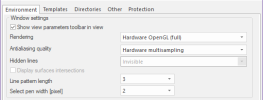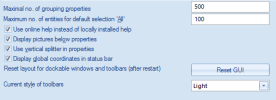Environment settings
Parameters affecting the user interface appearance make up this group of Environment settings.
Window settings
|
Show scrollbar in view |
This item specifies whether the graphical windows are equipped with scroll-bars on their right and bottom edges. |
|
The item sets the mode that is used for drawing into application graphical windows. |
|
|
Allows smoother rendering. Most visible on inclined lines displayed on rectangular pixel matrix of monitors with low resolution. |
|
|
This option specifies the mode for hidden lines of individual structural entities. |
|
|
Display surfaces intersections |
This check-box allows user to display the intersection of two surfaces. Option is available only for some rendering modes. |
|
This item specifies the style of dashed lines. |
|
|
Select pen width |
Allows user to defined the default width of pen for entities not included in Palette settings (Setup - Colours/Lines). |
Rendering
Defines the type of rendering.
| No | This option disables any rendering. The drawing on the screen is fast but reverse surfaces of the structure cannot be hidden. |
| No (calculate hidden lines) | This option disables any rendering but allows reverse surfaces of the structure to be hidden. It is slow way of displaying of the model since the visibility of lines is calculated by the processor. |
| Software OpenGL (emulation) | This options uses the computer's processor to simulate the rendering capability by means of software algorithms. This option should work properly on all computers. It may lead to a longer response of the computer during regeneration of the screen, however it may be useful in case of problems with graphic card. |
| Hardware OpenGL | If this option is selected, the hardware rendering capability of the computer's graphic card is employed. This option may lead to a "distorted" display on some computers, especially those with older models of graphic cards. |
| Hardware OpenGL (full) | This option is similar to 'Hardware OpenGL' with some additional rendering capabilities: volumes can be rendered during commands execution (such as input, copy, move, etc.). With this setting, there are additional options (Wired, Transparent with back edges, Solid with back edges, or Solid) for preselection and selection highlighting and edited entities rendering in the 'Advanced graphics setup'. |
When using 'Open GL (full)' is used, it is recommended to set 'Select pen width [pixel]' to a value of 3 or higher in order to see the highlighting of members when surfaces are not turned on.
From version 18, SCIA Engineer introduced the Navicube 3D navigation system. That system is available only with hardware OpenGL rendering. Compatibility issues have been noted on some computer systems, when 3D accelerations are not properly supported. For more details, see OpenGL textures troubleshooting.
Hidden lines
The Hidden lines option serves as a substitute for full and proper rendering if the Rendering itself is disabled.
The available options are:
|
Invisible |
The hidden lines (hidden parts of entity surfaces) are not drawn at all. |
|
Dashed |
The hidden lines are drawn in dashed style. |
In addition to the above-mentioned options, it is possible to select whether the intersections of individual surfaces should be calculated and displayed.
Note: The settings made here determine which mode of rendering and hidden line display is set for the application. This setting does not mean that the rendering of the scene (i.e. of what is displayed on the screen) is really applied. To do so, the rendering must be switched on for the required graphical window. This can be done by means of the appropriate view parameter for the appropriate graphical window.
Line pattern length
This item affects the style of dashed lines. The dashed lines may be used whenever within the projects. Any dashed line is controlled by this item.
Small number means short lines used in the dashed line with smaller gaps in between.
Large number means long lines used in the dashed line with longer gaps in between.
Command settings
Following setting is related to using commands in Command line.
|
Right mouse button click generates End of function |
If this option is ticked, the right mouse button generates End of command when pressed in any opened function such as definition of a new 1D member, move of 1D member, etc. |
|
Shift+Enter bypass input dialogue |
If this option is ticked, the command is immediately performed with last used set of properties (e.g. 'beam' command confirmed by Shift+Enter allows user to input the horizontal beam with last set of properties directly and properties input dialogue is skipped). |
|
Show default commands |
This button opens text file with the list of supported commands, default short-cuts and simple explanation. |
|
Customize short-cuts (restart needed) |
This button opens text file with the list of user-defined short-cuts. User can define own short-cuts in format <command>=<user_shortcut> (e.g. Structure.1d.Beam=usershortcut). |
Skins
Following settings influence the visual appearance of SCIA Engineer.
|
Select skin |
This option allows the user select from pre-defined screen skins of the application. |
|
Select style |
This option allows the user select from pre-defined colour schemes of the particular skin. |
|
Transparency settings |
This option allows the user select the value of transparency for entities using transparency (e.g. floating undocked windows). |
Other parameters
|
Maximum number of grouping properties |
This value determines the maximum number of entities that can be selected at a time so that the Property window was filled with the parameters of the selected entities. If the number specified here is exceeded, the property window is left blank and can be filled in only on user’s explicit request. |
|
Maximum number of entities for default selection 'All' |
This value determines if in Properties of result services the DEFAULT (i.e. before the user change) value of Selection is All or Current, related to the number of entities in project. If the number of entities in actual project is bigger than this limit, the default value of Selection will be Current and in default no results will be printed after refresh in order to prevent the long presentation time on large projects. |
|
F1 opens online help instead of locally installed help |
By default, the F1 opens the online help. The local help may be used when user works offline. |
|
Display pictures below properties |
This check-box controls whether the explaining picture under the Property window is displayed or not. |
|
Use vertical splitter in properties |
Enables user to set the horizontal position of vertical splitter in 'Properties' window. |
|
Display global coordinates in status bar |
By default, the status bar displays co-ordinates defined in an active user co-ordinate system. In addition, the global co-ordinates may be displayed as well. |
|
Reset layout for dockable windows and toolbars (after restart) |
This button loads the program-default settings of toolbars and windows layout. Reset will be taken into effect after the restart of application. |
|
Current style of toolbars |
In this combo-box user can select the predefined set of toolbars. |
For setting of application options see chapter Adjusting the application options.




